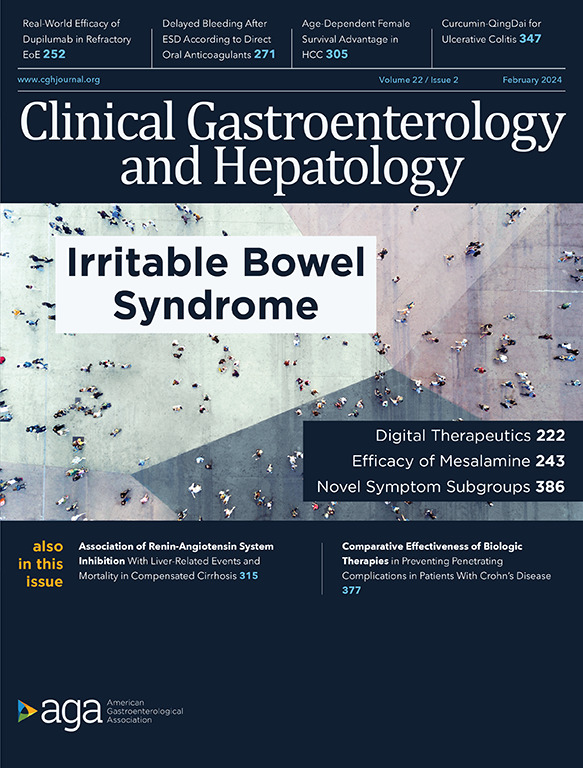Identification of Candidates for MASLD Treatment With Indeterminate Vibration-Controlled Transient Elastography
IF 12
1区 医学
Q1 GASTROENTEROLOGY & HEPATOLOGY
引用次数: 0
Abstract
Background and Aims
A noteworthy proportion of patients with metabolic dysfunction–associated steatotic liver disease (MASLD) have an indeterminate vibration-controlled transient elastography (VCTE). Among these patients, we aimed to identify candidates for MASLD treatment by diagnosing significant fibrosis.
Methods
This was a real-world prospective study including a large dataset of MASLD patients with paired VCTE and liver biopsy from 6 centers. A total of 1196 patients were recruited and divided in training (3 centers, Spain), internal validation (2 centers, Spain), and external validation (1 center, United States) cohorts. In patients with indeterminate liver stiffness measurement (LSM) (8–12 kPa), a diagnostic algorithm was developed to identify significant fibrosis, defined as histological stage ≥F2. Statistical analysis was performed using Gaussian mixture model (GMM) and k-means unsupervised clusterization.
Results
From the eligible population, 33%, 29%, and 31% had indeterminate VCTE in the training, internal and external validation samples, respectively. The controlled attenuation parameter allowed the differentiation of GMM clusters with a cutoff of 280 dB/m (area under the curve, 0.89; 95% confidence interval, 0.86–0.97). Within patients with <280 dB/m, a LSM between 8.0–9.0 kPa showed a 93% sensitivity and a 91% negative predictive value to exclude significant fibrosis. Among patients with ≥280 dB/m, a LSM between 10.3 and 12.0 kPa diagnosed significant fibrosis with a 91% specificity. Applying this algorithm to the validation cohorts, 36% of the indeterminate VCTE were reallocated. The reallocated high-risk group showed a prevalence of 86% significant fibrosis, opening the therapeutic window for MASLD patients.
Conclusions
To identify candidates for MASLD treatment among indeterminate VCTE, an algorithm-based on the sequential combination of LSM and controlled attenuation parameter thresholds can optimize the diagnosis of moderate-to-advanced fibrosis.

利用不确定振动控制瞬态弹性成像技术确定 MASLD 治疗候选者。
背景与目的:代谢功能障碍相关性脂肪性肝病(MASLD)患者中,有相当一部分人的振动控制瞬态弹性成像(VCTE)结果不确定。在这些患者中,我们旨在通过诊断明显的纤维化来确定MASLD治疗的候选者:真实世界的前瞻性研究,包括来自 6 个中心的大量配对 VCTE 和肝活检的 MASLD 患者数据集。共招募了1196名患者,并将其分为培训组(西班牙的3个中心)、内部验证组(西班牙的2个中心)和外部验证组(美国的1个中心)。对于肝脏硬度测量结果不确定(LSM:8-12 kPa)的患者,开发了一种诊断算法来识别明显的肝纤维化,其定义为组织学分期≥F2。统计分析采用高斯混合模型(GMM)和k-means无监督聚类:在符合条件的人群中,分别有 33%、29% 和 31% 的人在训练样本、内部样本和外部验证样本中存在不确定的 VCTE。受控衰减参数(CAP)允许以 280 dB/m 为临界值区分 GMM 聚类(AUC:0.89 [95%CI:0.86-0.97])。结论为了在不确定的 VCTE 患者中确定 MASLD 治疗的候选者,基于 LSM 和 CAP 阈值顺序组合的算法可以优化中晚期纤维化的诊断。
本文章由计算机程序翻译,如有差异,请以英文原文为准。
求助全文
约1分钟内获得全文
求助全文
来源期刊
CiteScore
16.90
自引率
4.80%
发文量
903
审稿时长
22 days
期刊介绍:
Clinical Gastroenterology and Hepatology (CGH) is dedicated to offering readers a comprehensive exploration of themes in clinical gastroenterology and hepatology. Encompassing diagnostic, endoscopic, interventional, and therapeutic advances, the journal covers areas such as cancer, inflammatory diseases, functional gastrointestinal disorders, nutrition, absorption, and secretion.
As a peer-reviewed publication, CGH features original articles and scholarly reviews, ensuring immediate relevance to the practice of gastroenterology and hepatology. Beyond peer-reviewed content, the journal includes invited key reviews and articles on endoscopy/practice-based technology, health-care policy, and practice management. Multimedia elements, including images, video abstracts, and podcasts, enhance the reader's experience. CGH remains actively engaged with its audience through updates and commentary shared via platforms such as Facebook and Twitter.

 求助内容:
求助内容: 应助结果提醒方式:
应助结果提醒方式:


